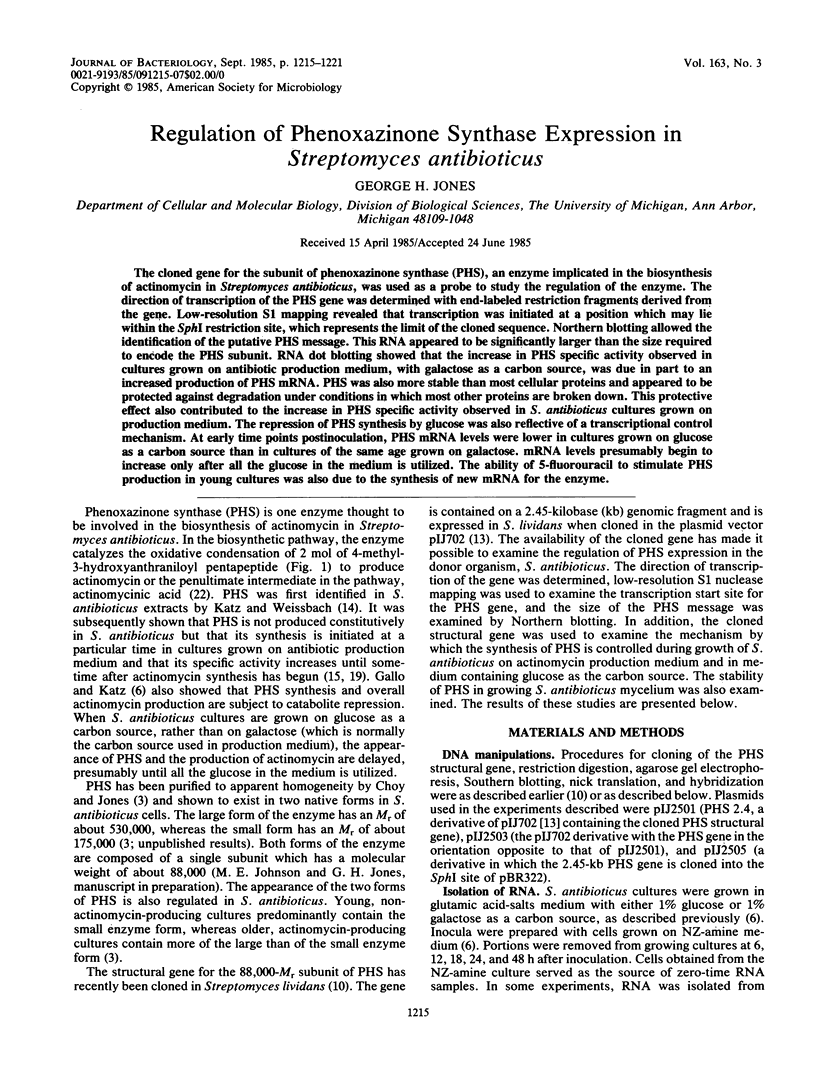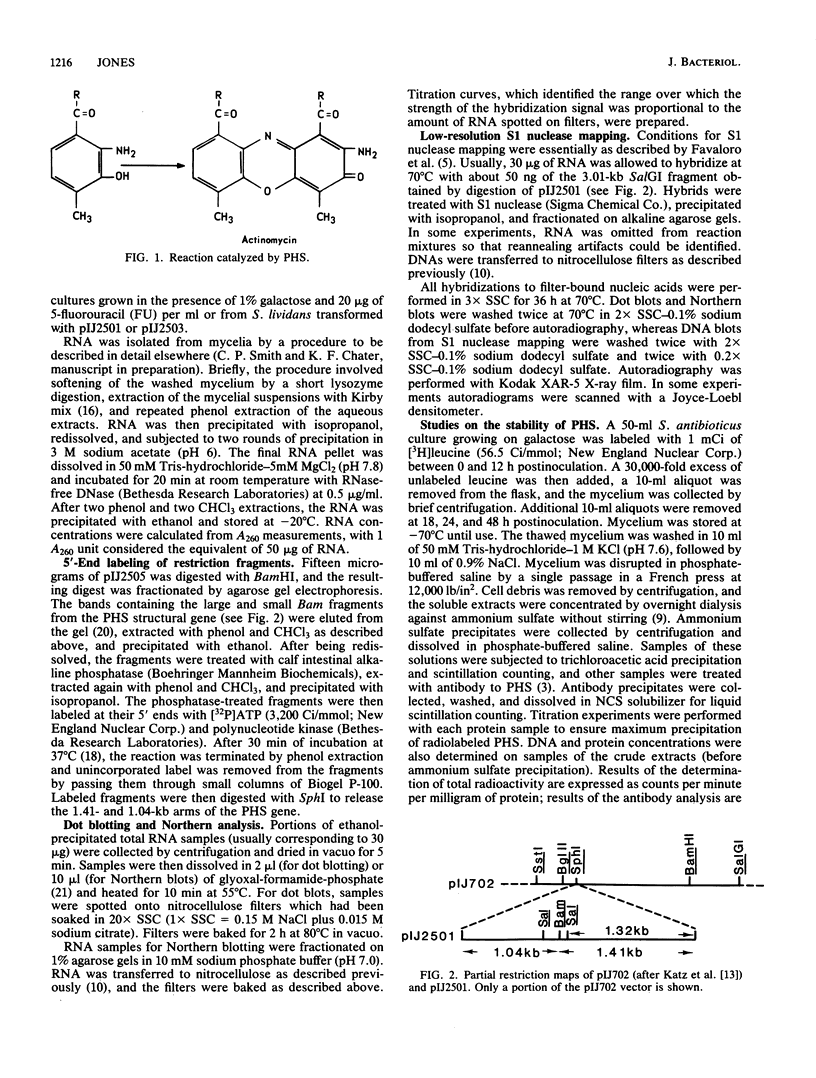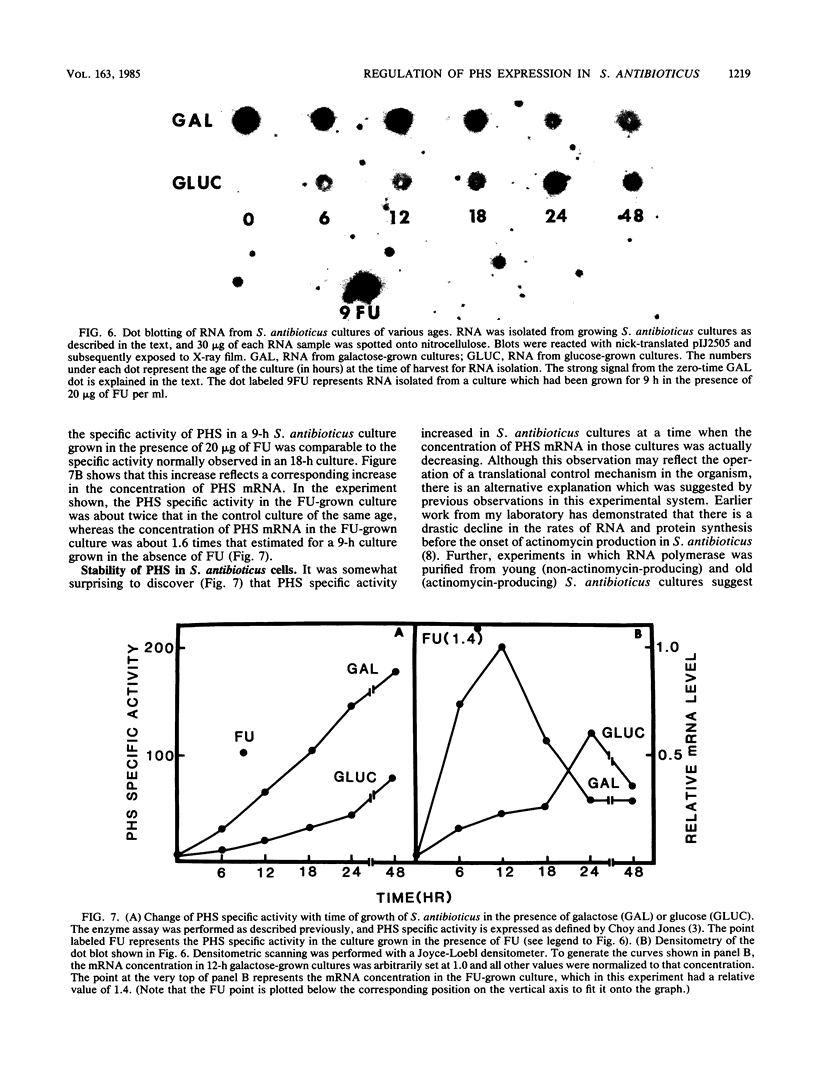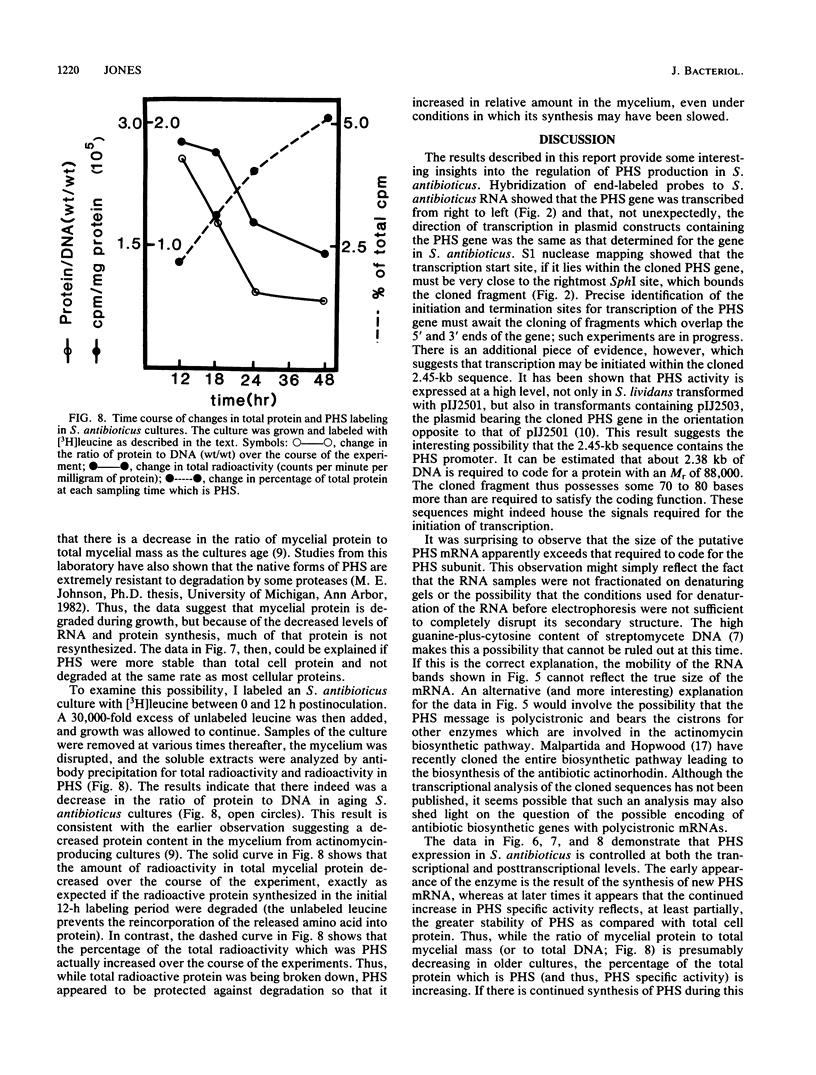Abstract
The cloned gene for the subunit of phenoxazinone synthase (PHS), an enzyme implicated in the biosynthesis of actinomycin in Streptomyces antibioticus, was used as a probe to study the regulation of the enzyme. The direction of transcription of the PHS gene was determined with end-labeled restriction fragments derived from the gene. Low-resolution S1 mapping revealed that transcription was initiated at a position which may lie within the SphI restriction site, which represents the limit of the cloned sequence. Northern blotting allowed the identification of the putative PHS message. This RNA appeared to be significantly larger than the size required to encode the PHS subunit. RNA dot blotting showed that the increase in PHS specific activity observed in cultures grown on antibiotic production medium, with galactose as a carbon source, was due in part to an increased production of PHS mRNA. PHS was also more stable than most cellular proteins and appeared to be protected against degradation under conditions in which most other proteins are broken down. This protective effect also contributed to the increase in PHS specific activity observed in S. antibioticus cultures grown on production medium. The repression of PHS synthesis by glucose was also reflective of a transcriptional control mechanism. At early time points postinoculation, PHS mRNA levels were lower in cultures grown on glucose as a carbon source than in cultures of the same age grown on galactose. mRNA levels presumably begin to increase only after all the glucose in the medium is utilized. The ability of 5-fluorouracil to stimulate PHS production in young cultures was also due to the synthesis of new mRNA for the enzyme.
Full text
PDF






Images in this article
Selected References
These references are in PubMed. This may not be the complete list of references from this article.
- CERIOTTI G. A microchemical determination of desoxyribonucleic acid. J Biol Chem. 1952 Sep;198(1):297–303. [PubMed] [Google Scholar]
- Chatterjee S., Vining L. C. Intracellular adenosine triphosphate and cyclic adenosine 3',5'-monophosphate concentrations during derepression of actinomycin biosynthesis. Can J Microbiol. 1982 Dec;28(12):1396–1399. doi: 10.1139/m82-207. [DOI] [PubMed] [Google Scholar]
- Choy H. A., Jones G. H. Phenoxazinone synthase from Streptomyces antibiotics: purification of the large and small enzyme forms. Arch Biochem Biophys. 1981 Oct 1;211(1):55–65. doi: 10.1016/0003-9861(81)90429-x. [DOI] [PubMed] [Google Scholar]
- Favaloro J., Treisman R., Kamen R. Transcription maps of polyoma virus-specific RNA: analysis by two-dimensional nuclease S1 gel mapping. Methods Enzymol. 1980;65(1):718–749. doi: 10.1016/s0076-6879(80)65070-8. [DOI] [PubMed] [Google Scholar]
- Gallo M., Katz E. Regulation of secondary metabolite biosynthesis: catabolite repression of phenoxazinone synthase and actinomycin formation by glucose. J Bacteriol. 1972 Feb;109(2):659–667. doi: 10.1128/jb.109.2.659-667.1972. [DOI] [PMC free article] [PubMed] [Google Scholar]
- Jones G. H., Hopwood D. A. Activation of phenoxazinone synthase expression in Streptomyces lividans by cloned DNA sequences from Streptomyces antibioticus. J Biol Chem. 1984 Nov 25;259(22):14158–14164. [PubMed] [Google Scholar]
- Jones G. H., Hopwood D. A. Molecular cloning and expression of the phenoxazinone synthase gene from Streptomyces antibioticus. J Biol Chem. 1984 Nov 25;259(22):14151–14157. [PubMed] [Google Scholar]
- Jones G. H. Purification of RNA polymerase from actinomycin producing and nonproducing cells of Streptomyces antibioticus. Arch Biochem Biophys. 1979 Nov;198(1):195–204. doi: 10.1016/0003-9861(79)90410-7. [DOI] [PubMed] [Google Scholar]
- Jones G. H. RNA synthesis in Streptomyces antibioticus: in vitro effects of actinomycin and transcriptional inhibitors from 48-h cells. Biochemistry. 1976 Jul 27;15(15):3331–3341. doi: 10.1021/bi00660a025. [DOI] [PubMed] [Google Scholar]
- Jones G. H., Weissbach H. RNA metabolism in Streptomyces antibioticus; effect of 5-fluorouracil on the appearance of phenoxazinone synthetase. Arch Biochem Biophys. 1970 Apr;137(2):558–573. doi: 10.1016/0003-9861(70)90473-x. [DOI] [PubMed] [Google Scholar]
- KATZ E., WEISSBACH H. Biosynthesis of the actinomycin chromophore; enzymatic conversion of 4-methyl-3-hydroxyanthranilic acid to actinocin. J Biol Chem. 1962 Mar;237:882–886. [PubMed] [Google Scholar]
- Katz E., Thompson C. J., Hopwood D. A. Cloning and expression of the tyrosinase gene from Streptomyces antibioticus in Streptomyces lividans. J Gen Microbiol. 1983 Sep;129(9):2703–2714. doi: 10.1099/00221287-129-9-2703. [DOI] [PubMed] [Google Scholar]
- Kirby K. S., Fox-Carter E., Guest M. Isolation of deoxyribonucleic acid and ribosomal ribonucleic acid from bacteria. Biochem J. 1967 Jul;104(1):258–262. doi: 10.1042/bj1040258. [DOI] [PMC free article] [PubMed] [Google Scholar]
- Malpartida F., Hopwood D. A. Molecular cloning of the whole biosynthetic pathway of a Streptomyces antibiotic and its expression in a heterologous host. 1984 May 31-Jun 6Nature. 309(5967):462–464. doi: 10.1038/309462a0. [DOI] [PubMed] [Google Scholar]
- Marshall R., Redfield B., Katz E., Weissbach H. Changes in phenoxazinone synthetase activity during the growth cycle of Streptomyces antibioticus. Arch Biochem Biophys. 1968 Feb;123(2):317–323. doi: 10.1016/0003-9861(68)90141-0. [DOI] [PubMed] [Google Scholar]
- Tautz D., Renz M. An optimized freeze-squeeze method for the recovery of DNA fragments from agarose gels. Anal Biochem. 1983 Jul 1;132(1):14–19. doi: 10.1016/0003-2697(83)90419-0. [DOI] [PubMed] [Google Scholar]
- Thomas P. S. Hybridization of denatured RNA and small DNA fragments transferred to nitrocellulose. Proc Natl Acad Sci U S A. 1980 Sep;77(9):5201–5205. doi: 10.1073/pnas.77.9.5201. [DOI] [PMC free article] [PubMed] [Google Scholar]
- Troost T., Katz E. Phenoxazinone biosynthesis: accumulation of a precursor, 4-methyl-3-hydroxyanthranilic acid, by mutants of Streptomyces parvulus. J Gen Microbiol. 1979 Mar;111(1):121–132. doi: 10.1099/00221287-111-1-121. [DOI] [PubMed] [Google Scholar]
- WEISSBACH H., KATZ E. Studies on the biosynthesis of actinomycin: enzymic synthesis of the phenoxazone chromophore. J Biol Chem. 1961 Mar;236:PC16–PC18. [PubMed] [Google Scholar]
- de Crombrugghe B., Busby S., Buc H. Cyclic AMP receptor protein: role in transcription activation. Science. 1984 May 25;224(4651):831–838. doi: 10.1126/science.6372090. [DOI] [PubMed] [Google Scholar]






